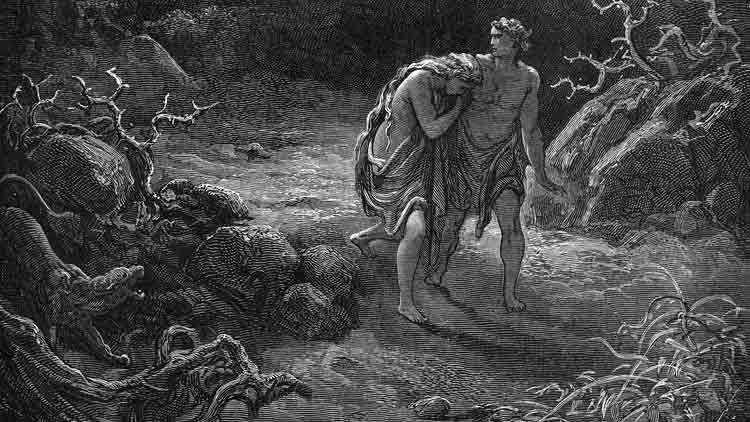I received an email from Judy Gatewood that forms a perfect bridge from the sermons on Humor, to the sermons on the Heroes of Faith. It purports to be “a reading from Genesis.” I have been unable to find it there, perhaps you can. Judy quotes:
And God promised men that submissive and obedient wives would be found in all corners of the earth. Then God made the earth round. And God laughed and laughed and laughed.
We begin this series on the Heroes of Faith with a pair of anti-heroes, or villains, named Adam and Eve. In a real sense, all the heroes of the Bible are in a fight against Adam and his partners, and I use that word, “partners,” advisedly. Perhaps you remember the comic strip Pogo, written by the late Walt Kelly. It was Pogo who said, “We have met the enemy and he is us.” That is good theology. It means that no amount of interference and temptation from the outside is a powerful as the interference and temptation we partners of Adam have in our own hearts.
The senior partner in all crime against God is Adam.
Adam has two meanings in Hebrew. On the one hand “adam” means humankind, and it reminds us that humankind was taken “from the earth.” On the other hand, “Adam” is also a name, like “Adam Smith,” or “Adam Cartwright.” When someone in the Bible uses the name Adam they may be referring to a single individual, or to the whole race of man, or to both. For instance, when St. Paul refers to the man Adam, he refers to him as the representative of the whole human race. Thus in 1st Corinthians 15:22 the apostle says:
22 For as in Adam all die, so also in Christ shall all be made alive.
According to St. Paul you and I are either in Adam, which means that we are a part of sinful humanity, and partners in crime against God. Or, we are “in Christ,” which means that our sins are forgiven, and we have received the promised Holy Spirit by which we were sealed against the day of Redemption. (Ephesians 4:30) The day of Redemption is that day on which all God’s promises to us will become a reality, including eternal life. It is impossible to overestimate the importance of being in Christ, for, as Paul writes in In 1st Corinthians 15:45:
“The first man Adam became a living being”; the last Adam (Jesus Christ) became a life-giving spirit.
Lets talk about the Creation for a minute.
Many times we speak of the story of Creation as if there was only one. By my count, there are more than half-a-dozen creation stories in the Bible. My two personal favorites are in the New Testament.
In John 1:1-3 we read:
“1 In the beginning was the Word, and the Word was with God, and the Word was God. 2 He was in the beginning with God; 3 all things were made through him, and without him was not anything made that was made. ”
This means that Jesus Christ is co-creator with God.
Then in Colossians 1:15 we read:
“15 He is the image of the invisible God, the first-born of all creation; 16 for in him all things were created, in heaven and on earth, visible and invisible.”
“He” refers to Jesus Christ. I love that all things were created “in him,” whether visible or invisible. We might easily translate that all things were created in Christ whether known, or unknown. We don’t know all we want to know about our world and its creation, but we know that each bit of new knowledge we gain fits easily into the character of God as revealed “in Jesus Christ.”
There are two creation stories in the first three chapters of Genesis, and each compliments the other.
The first story of creation is found in Genesis 1:1-2:3. The heart of this story is found in Genesis 1:27-28. It records the events of the 6th day of creation.
27 So God created man in his own image, in the image of God he created him; male and female he created them. 28 And God blessed them, and God said to them, “Be fruitful and multiply, and fill the earth and subdue it; and have dominion over the fish of the sea and over the birds of the air and over every living thing that moves upon the earth.”
There are two things I would have you to note.
Note that man is created. In this regard we are like the animals. We are creatures of the earth. We are finite. We live in one time and in one place, and our lives are marked by birth and death.
Note that man was not just created, but created in the image of God. We share the divine life. For almost three thousand years believers have debated what it means to be created in the image of God. It cannot mean that we look like God. We are flesh and bone, and in John 4:24 Jesus himself said, “God is Spirit.” It cannot mean that we have God abilities. We are weak. God is strong. The Bible teaches God is all-knowing, and all-powerful, and all-over. I believe that the fact that we are made in the image of God means that we posses a measure of the Divine freedom. The animals are ruled by instinct, but human beings are seldom left without a choice. The animals go south in the winter according to their instinct. We can travel north in winter. We can do right, or we can do wrong. Victor Frankel says there is one freedom that can never be taken from us: The freedom we have to choose how we respond to what life dishes out to us. Just this week a man facing a risky cancer surgery said to me, “If I wake up after the surgery and see the face of my wife, I know I will be o.k., and if I wake up and see the face of Jesus, I know I will be o.k.” That is a profoundly Christian Response. He has been freed from the fear of sin and death.
The 2nd story of creation is found in Genesis 2:4-3:24. According to the 2nd story of creation, God created a single individual by the name of “Adam,” or “the man.” God created Adam from the dust of earth, and breathed into him the breath of life. Once more we see that man is created like the animals, but we breathe the very breath of God. God made Adam, and then God put Adam in a garden, and told him to tend and keep it. Then, in an attempt to find a helper for “the man” God made the animals. In the first story, man is created after the animals. In this story the animals are created after man. There is no real contradiction. The first declares God saved the best for last, that man is the apex of creation The second story declares that man is preeminent. It is all the same. . In either case we are “the apple of God’s eye.”
As God made the animals from the dust of the earth, God invited the man to name the animals. The first task of science is naming things, so Adam can be said to be both a gardener (or a farmer) and a scientist. According to Genesis 2:17-18 the man gave names to the beasts of the field, and to the birds of the air, and everything else; but he did not find a fit helper.
The man was lonely, and disappointed, but God took pity on him. According to the story, God made a deep sleep to fall upon the man, and while he was asleep, God took one of the man’s ribs, and God used that rib to make a woman. When the man woke up and saw what God had done he said:
This at last is bone of my bones and flesh of my flesh; she shall be called woman, because she was taken out of man.
When I was in 4th Grade at South Park School, WTOB Radio used to play a song that folded the two stories of creation together. Gene McDaniels sang it. It went:
HE took a hundred pounds of clay, and he said, “Hey listen!”
I am going to fix this world today, because I know what’s missin’.
Then he rolled his big sleeves up, and a whole new world began,
He created a woman, and—-lots of loving’ for a man.
In this act of creating human beings, male and female, God adds the possibility of human love to the reality of divine love, which God has always showered upon us.
God also introduces the concept of marriage. The Bible does not tell how the first pair married. There was no preacher, and no justice of the peace. Some say that God presided at the wedding. All we know is that Adam declares the woman to be “bone of my bone and flesh of my flesh,” and then, the next verse declares:
Therefore a man leaves his father and his mother and cleaves to his wife,
and the two become one flesh.
Flesh is important. It is worth nothing that in scripture marriage is always about a physical union, for the physical affects everything. Though the physical union can be broken, as in death or in divorce, the psychological and spiritual union that grows out of the physical union stays with us. In most marriages, this union becomes visible in the children that are born to the union. Truly, in marriage, two people, a man and a woman, become one flesh. Once we have sexually joined ourselves to another that other becomes a part of us forever. Young people thinking about rushing into sex should think about this.
This is another prime example of the way the Bible works. The Bible starts off talking about the first pair, the man and the woman, Adam and Eve, and then it starts talking about all men, and all women, even us, for the verse about “leaving” and “cleaving” it is written in the present tense, and all husbands and all wives are “one flesh.” This allows me to make a key point.
When we read about Adam and Eve we are reading about our selves. The story of creation of Adam and Eve is the story of our creation. The Bible tells this story in language that so pure and simple that even a child can understand it. However it would be a mistake to think of these stories as simplistic. These stories are not simplistic; they are the simplicity that lies on the far side of all complexity. They represent a timeless simplicity that will never be challenged or changed by the latest scientific discovery.
Does this mean that these stories are anti-science? I don’t think so. Let me see if I can draw it out.
First put yourself in the place of the people who first heard these stories. They were not schooled in science and technology. They lived more than 2,000 years before Copernicus, Galileo, Charles Darwin, Albert Einstein, Thomas Alva Edison, Steve Jobs, or any other scientists or technologist we can name. By the standards of today, the people who first heard these stories were a part of humankind when humankind was still in its age of adolescence. Remember, High School students of today know more about the world we live in than Ph.D.’s of the 19th century. The gap between the adults of today, and adults of 3,000 years ago is even greater.
Now put yourself in the place of God for a moment. God knew that these stories would be read and told for thousands of years—almost three thousand already. God knew that these stories had to be told in such a way that they would be meaningful for people who assumed that the world was flat, and the sky just a dome that separated the earth from the heaven that was inhabited by God, and equally meaningful for people who would look at the limitless universe through a Hubble Telescope, and travel to the moon. In other words, these stories, inspired by God, had to be told in such a way as to appeal to young children, and to sophisticated adults including, engineers, and doctors, and scientists.
A distinguished scientist, and a devout Christian, once came to me and told me he was having a hard time relating his faith—which he said was firm, to the creation stories of Genesis. I knew his faith. He had survived the death of his first wife, the Second World War, and the death of a son. I knew his science. He had held a prominent position.
I told him that there did not have to be any conflict between his science and his faith. I explained like this.
I said, “Suppose you have to write a letter to a fellow scientists. You could assume a certain level of knowledge and use a specialized vocabulary could you not?” He said that he could. I continued, “Well, suppose you have to write a letter on the same subject to the eleven or twelve year old son of that scientist. Could you use the same vocabulary, and assume the same level of knowledge?”
“Of course not,” he said, “I would have to write to the level of the boy’s understanding.”
I asked him a final question. I asked, “If you were writing one letter to the scientist and to his son to what level would you write?”
He gave the answer I knew he would. He said, “I would write to the level of the son, knowing that the father could understand it, too.”
That is precisely what God did when God inspired holy men of old, moved by the Holy Spirit, to give us the creation stories of the Bible. God caused those stories to be told in language that is as sublime as it is simple. These stories speak to all people of all ages, whether an adults or a children. And these stories speak to people of all centuries, the 10th century B.C., or the 21st Century A.D.
I think I can make my point from scripture. In 1st Corinthians 13, St. Paul writes a commentary on our Christian knowledge of salvation. I think it also applies to knowledge in general. I think it certainly applies to the story of creation. The Apostle writes:
9 For our knowledge is imperfect and our prophecy is imperfect; 10 but when the perfect comes, the imperfect will pass away. 11 When I was a child, I spoke like a child, I thought like a child, I reasoned like a child; when I became a man, I gave up childish ways. 12 For now we see in a mirror dimly, but then face to face. Now I know in part; then I shall understand fully, even as I have been fully understood.
What does all this mean? It means that we don’t know everything about our world, or even about our salvation, but each time we discover something new we can be sure it fits “in Christ.” More importantly, we know that even before God created the first Adam, he already had the Last Adam in view, and our ultimate destiny is not to be partners in the rebellion against God with the first Adam, and all who are solidly in union with him, but to enjoy God’s forgiveness, and the life of the Spirit, find our true destiny in the Last Adam, that is, in Jesus Christ.
Finis
Worth Green, Th.M., D.Min.
Image “Adam and Even Driven from the Garden” from Dore Biblical Illustrations available at the Guttenberg Press and in the Public Domain.







